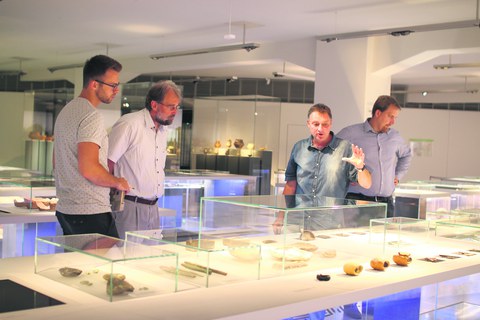The “Lernlandschaft Sachsen” project is growing

From left to right: Robert Wilsdorf, Prof. Frank-Michael Kuhlemann, Peter Degenkolb, and Josef-Tobias Wils at the Staatliches Museum für Archäologie Chemnitz (SMAC) archeology museum, one of the new partner sites.
Dresden Royal Palace and SMAC join the project
Beate Diederichs
The project is strengthening its collaboration with existing field trip partners and establishing new ones, including outside Dresden. The four-person project team is now thinking about how “Lernlandschaft Sachsen” (“Saxony’s Learning Landscape”) could continue beyond the project period initially planned, which is due to end in just under a year.
By early summer of this year, “Lernlandschaft Sachsen” already boasted some impressive names. The project team collaborates with five Dresden museums: Adventureland Mathematics, which is part of the Technische Sammlungen Dresden, the Mathematisch-Physikalischer Salon and the Albertinum, both under the umbrella of the Dresden State Art Collections (SKD), the LernLaborFarbe lab at TU Dresden, and the Schulmuseum Dresden school museum. “We are strengthening and developing our partnerships with all participating sites on an on-going basis,” explains project coordinator Josef-Tobias Wils. Strengthening partnerships means, for example, that the sites are integrated into the project seminar program, creating long-term contacts between the staff of the museums and laboratories and TUD’s trainee teachers. Students can make use of those contacts later when they start teaching. Project staff also help the museums with new educational services and provide support with training.
Two more museum “heavyweights” have joined the project in recent months: the Dresden Royal Palace, part of SKD like the Albertinum and the Mathematisch-Physikalischer Salon, and the archaeology museum SMAC in Chemnitz. SMAC joining the project represents a major step: This is the first partnership agreement with a site outside Dresden. “This partnership came about because I worked with SMAC staff as part of my Master’s thesis: ‘The Staatliches Museum für Archäologie Chemnitz as a site for history field trips. A history teaching analysis,’” Robert Wilsdorf tells us. Wilsdorf joined the team in 2018 and is responsible for history teaching. Josef-Tobias Wils covers math and chemistry, Wiebke Kuske-Janßen physics and Dr. Claudia Blei-Hoch German. “I found SMAC to be very open to collaboration,” says Robert Wilsdorf. Peter Degenkolb, SMAC’s education and visitor services officer, sees his museum as an appealing destination for school groups, and wants to see it develop further. “The partnership with TUD enables us to create a program that reflects the latest methodology and teaching practice and really works for pupils. Our partnership raises our profile as a potential destination with teachers, trainee teachers, and students, and gives them the opportunity to develop projects together with us,” he explains.
Josef-Tobias Wils’ project team would like to add many more partner sites for school visits both within and beyond Dresden. “But the size of our team unfortunately limits the number of partnerships we can manage,” he says. The project itself runs until June 30, 2019. “Of course, we are already thinking about how we can make it permanent.” So far, the work of the project team has been used in 19 classes since the launch of “Lernlandschaft Sachsen” in 2016, and there has been great interest from students. Wils tell us that “to encourage even more students to sign up for our courses, we would like those courses to be part of the elective options in the medium term, rather than listed as supplementary classes, as they are now.” “Lernlandschaft Sachsen” is part of the “Synergetic Teacher Education” (TUD-Sylber) action plan aimed at strengthening teacher training at TU Dresden.
This article appeared in the Dresdner Universitätsjournal (university newspaper, UJ) 13/2018 of September 4, 2018. The complete issue is available as a free PDF download here. Printed copies and PDF files of the university newspaper can be ordered from doreen.liesch@tu-dresden.de. More information can be found at universitaetsjournal.de.
